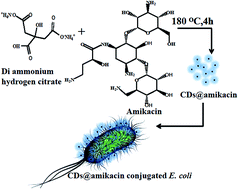One-step synthesis of amikacin modified fluorescent carbon dots for the detection of Gram-negative bacteria like Escherichia coli†
Abstract
In this paper, we report a one-step strategy to synthesize amikacin modified fluorescent carbon dots (CDs@amikacin) for assaying pathogenic bacteria, Escherichia coli. Amikacin is a well-known aminoglycoside antibiotic but here we used it as a binding ligand towards E. coli. Here the synthesized carbon dots are used to detect E. coli accompanied with a linear range of 3.904 × 105 to 7.625 × 102 cfu per mL as well as a detection limit of 552 cfu per mL. CDs@amikacin were well dispersed in water with an average particle diameter of ∼2.5 nm and exhibited a quantum yield of 12.35% at a excitation wavelength of 340 nm. The synthesis of CDs@amikacin and their use in the detection of E. coli are simple, cheap and effective process. This study is also successfully applied to the sensing of E. coli in different fruit juice samples like apple, pineapple and orange. We believe that this analytical method can be used in the field of public health as well as food safety.


 Please wait while we load your content...
Please wait while we load your content...